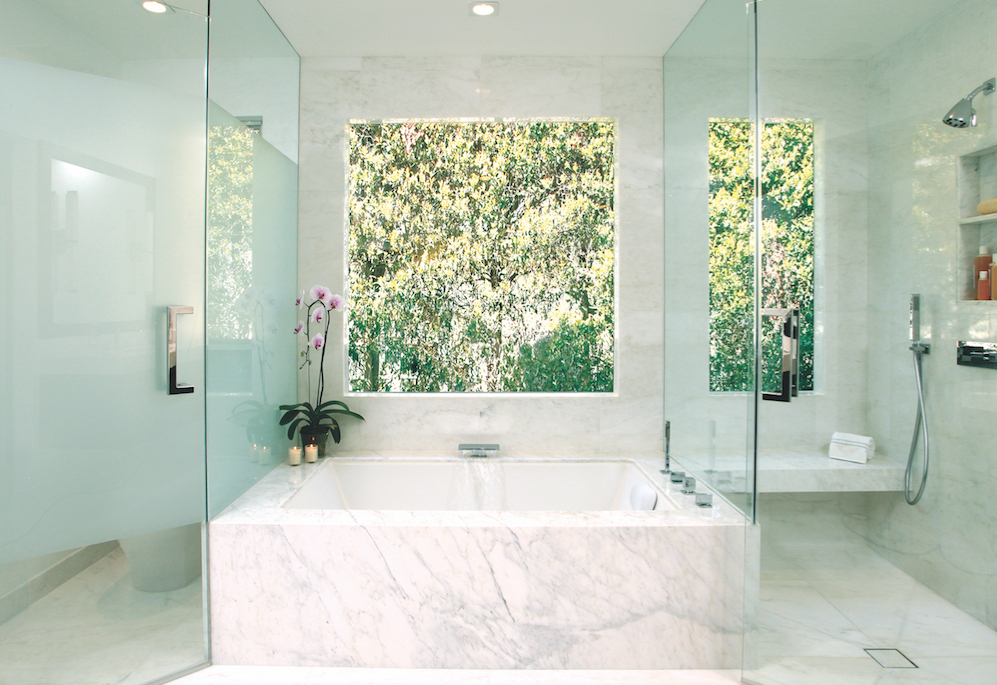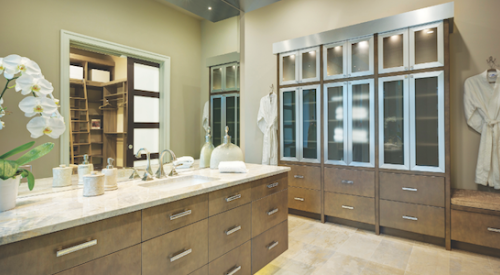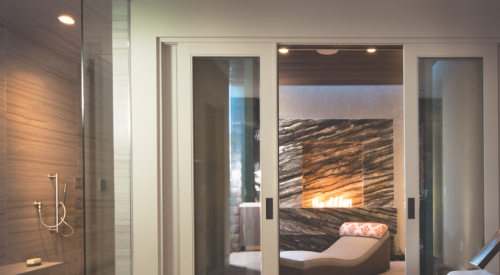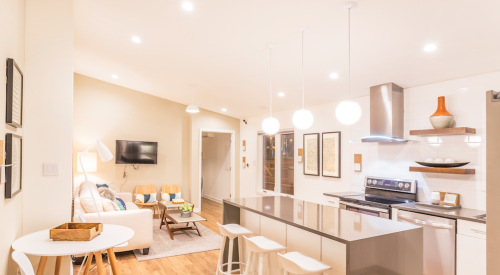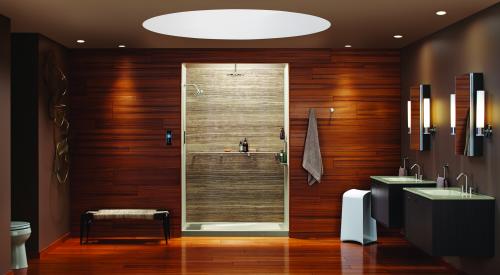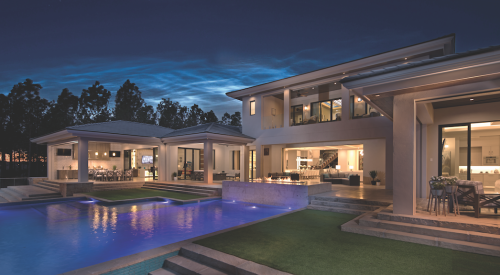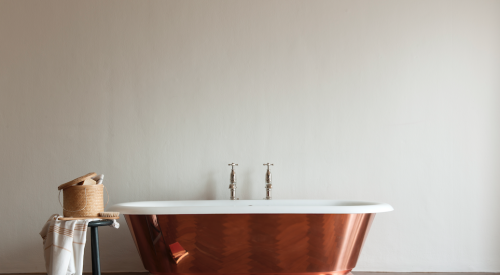Regional differences still exist in preferred styles across the country but, overall, transitional and contemporary are gaining over traditional designs. The clean-lined design that is on-trend is not a cold, minimalist modern but a rich layering of textures, colors, and materials with details often drawn from A desire for personalization in style and layout is coming into full bloom with homeowners of all ages. Figure in demands for hardworking storage, unobtrusive appliances, low-maintenance surfaces, updated technologies, and accessibility and you have a snapshot of kitchen and bath design trends in 2017.

Located in Chicago, this kitchen designed by Mick De Giulio of De Giulio Kitchen Design continues the trend toward open-plan kitchens that lead into other living spaces. (Photo: Dave Burk, Dave Burk Photography).
Personalization—always a hallmark of high-end kitchens and baths—is today in demand in all price ranges, a result of homeowners being exposed to varied styles and products through media and travel. They’re also focused less on dollar value. “It’s my perception that people are far less concerned about resale than they were 20 years ago,” says kitchen designer Mick De Giulio, principal of De Giulio Kitchen Design, in Chicago and Wilmette, Ill. “Today, I think people are most interested in creating spaces that they’ll actually use.”
Kitchen
Regional differences still exist in preferred styles across the country but, overall, transitional and contemporary are gaining over traditional designs. The clean-lined design that is on-trend is not a cold, minimalist modern but a rich layering of textures, colors, and materials with details often drawn from streamlined, distinctive styles of the past century that add visual and tactile interest. Christopher Grubb, president of Arch-Interiors Design Group, in Beverly Hills, Calif., for example, sees Shaker-style cabinetry gaining in popularity.
Bobby Berk, principal of Bobby Berk Interiors + Design, in Los Angeles, adds, “We’re seeing a huge demand for mid-century and farmhouse-inspired home designs in both production and custom homes. These styles have trickled down from the custom home building industry and are now incredibly popular in production home building.”
In Cabinets, A Mix of Styles
“Both light woods and gray tones are popular right now, as they allow for a wide range of changing trends as the home ages,” Berk says. “Two-tone kitchen cabinets as well as colored cabinets are very in.” Patricia Wynkoop, VP of product development and purchasing at residential developer and builder Miller & Smith, in McLean, Va., and Mary Jeanne Helton, EVP of residential design firm and building product manufacturer and distributor Signature Companies, in Haymarket, Va., see wood choices swinging toward quarter-sawn oak, with its straight grain that receives stain and color well, along with walnut, a straight-grained, strong, stable wood. Slab or frameless cabinet doors in white, gray, or greige, and even in matte black, mixed with solid white, gray, greige, or wood accents are also on trend.
Wynkoop and Helton view gray as the popular new neutral, paired with accents in muted pastels and jewel tones. For those who still prefer traditional styling, Steven Cooper, designer and owner of Cooper Pacific Kitchens, in West Hollywood, Calif., says, “We are looking at glazed, natural tones, open grains in wood, and furniture details in cabinetry.”
The Open Plan Prevails
A kitchen open to the great room remains the most popular layout. “Our floor plans feature the great room, kitchen, and dining areas all flowing effortlessly as one, with floor-to-ceiling windows that offer plenty of natural light,” says Robert Bowman, president of Charter Homes & Neighborhoods, in Lancaster, Pa. Wynkoop and Helton acknowledge that consumers are forgoing formal living and dining rooms, with kitchens integrated into the living/great room space. Accordingly, kitchen cabinetry is designed to look more like furniture. Cooper notes that some clients who have had open-plan kitchens are now pushing back a bit, requesting architectural features such as pocket doors, columns, or arches, to physically or visually delineate spaces.
Open-plan kitchens have prompted shifts in appliance-finish preferences. Grubb calls it “stainless fatigue,” whereby homeowners now want the unobtrusive look of appliances concealed behind panels that match the cabinetry. Another common request: less-prominent ventilation hoods that blend in with cabinetry. And integrated refrigeration has come down from very high-end kitchens to those that are somewhat more affordable, says designer David Stimmel, owner of Stimmel Consulting Group, in Bryn Mawr and Ambler, Pa. “Steam cooking is also a must-have now, with almost every new kitchen we see requiring this,” he says.
Special Attention to Storage

A luxurious kitchen by Mick De Giulio of De Giulio Kitchen Design includes the Metal Boy cabinet, also designed by De Giulio, to hold cookware. It has interior LED lighting and is lined with distressed German silver. (Photo: Dave Burk, Hedrich Blessing Photographers)
“Homebuyers are looking for smaller yet smarter square footage,” says Bobby Berk, principal of Bobby Berk Interiors + Design, in Los Angeles. The smart part involves options that offer efficient storage and smooth operation while preserving a kitchen’s uncluttered good looks.“Slide-outs, pullouts, drawer dividers, built-in bins, and charging stations within cabinets and drawers are some of today’s kitchen musts,” according to Patricia Wynkoop, VP of product development and purchasing at Miller & Smith, in McLean, Va.
Homeowners want cabinetry to be well-organized and accessible. “New hinges are more hidden and smaller than ever before, so you no longer see unsightly bulky hardware through beautiful glass fronts,” says Mick De Giulio, principal of Chicago-based De Giulio Kitchen Design. “We look for opportunities to use spaces that might otherwise go untouched. A corner recess to house a countertop appliance or spice shelves behind a range wall’s sliding backsplash.” Good, eco-wise lighting is a given. “LED is now standard for under-cabinet, interior, and overall ambient lighting,” De Giulio says.
Gone is the built-in desk area in the kitchen for taking care of household bills. “With the portability of laptops and tablets, the home office area is now on the island, which can include a power strip and HDMI connection and file drawers to hold household documents,” says Christopher Grubb, president of Arch-Interiors Design Group, in Beverly Hills, Calif.
An Emphasis on Entertaining

Ideal for entertaining, this secondary service kitchen in a Las Vegas model home is designed by Bobby Berk. It carries through the same materials and color scheme used in the primary kitchen. (Photo: Chris Meyer)
Many homeowners today enjoy entertaining and expect their kitchens to contribute aesthetically and functionally to the party. “Baby Boomers’ kids are gone, they’re downsizing, and they’re entertaining again,” Los Angeles designer Bobby Berk says. “So their kitchens aren’t necessarily bigger, but they’re smarter.”
“The classic triangle is updated with a more exciting approach,” says Steven Cooper, owner of Cooper Pacific Kitchens, in West Hollywood, Calif. “A kitchen might have multiple cooking and refrigeration zones that can handle meals for a family of four-to-five or a party of 100.”
Islands are key in providing a social setting; a place where people can sit and gather around. They can serve as design statements, encouraging the feeling of being in a special, lively area, integrating textures and tones or a distinctive mix of materials that contrast or complement the perimeter cabinetry. The goal is for the seating area at the island to be out of the cook’s way, yet integrated enough to allow for socializing.
With the popularity of the open-plan layout, Cooper says, “Islands are important today to integrate the eating area and create a good flow to adjoining spaces yet serve as a visual ‘stop sign’ from one space to the next.” Another popular must-have for those who frequently entertain is wine storage. The days of the wooden wine rack are over. “Walk-in wine storage can be an integrated jewel case in the kitchen,” Cooper says.
Berk’s Las Vegas kitchens have all had two dishwashers. Another highly popular kitchen upgrade he sees is the “service kitchen”—a small kitchen behind or off to the side of the main kitchen, which serves as a prep or clean-up zone for entertaining. “Instead of stacking the mess out in the open after a dinner party, one can instead put everything back there for cleanup after guests leave or the morning after,” he says.
Bath
Wynkoop and Helton note that many of the trends seen in kitchen design carry over into the bath as well. “Shaker and Scandinavian styles and white, gray, or greige painted cabinets are on trend,” they say. Other musts include clever storage, LED lighting, open storage, quartz or light-toned solid-surface countertops, glass doors and shelves, and decorative hardware. Custom vanities created from furniture pieces are also in demand.

Lindsay Chambers of Lindsay Chambers Design, designer of this master bath, sees a preference for clean lines and abundant light, including in kitchens and baths with traditional styling. Practical bath storage is in demand, as are dual vanities, which can be done in a variety of configurations. (Photo: Christopher Stark)
“I get the most requests for transitional and traditionally styled bathrooms that have a clean, slightly contemporary leaning,” says Lindsay Chambers, founder of Lindsay Chambers Interior Design, who primarily works in Los Angeles and San Francisco. “Light, clean, crisp, and airy are still the requests I am getting in terms of look and feel. White and cream marbles are still in.”
Architect Anne Postle, owner of Osmosis Art and Architecture, in Niwot, Colo., breaks style trends down by generation: “Modern or transitional for the Millennial and Gen-X buyer, and traditional or transitional for the Baby Boomer ... though modern is gaining popularity with Urban Boomers.”
Master Bath As Haven
The bath-as-spa concept is still alive and well. “Our bathrooms are designed to provide homebuyers with a spa-like sanctuary where they can escape the hustle and bustle of their daily routines,” Bowman says. Clean, sleek finishes include granite, marble, and ceramic tile that imitates real slate and stone. Chrome is the favored finish, along with large mirrors and spacious his-and-hers vanities.”
But bath design is about more than looks alone. “Buyers are considering how the layout and features in the bath support their busy lives,” Postle says. “Is there a place to sit and tie your shoes? Are the surfaces durable and easy to clean? How close is the laundry to the master bath? Do the cabinets have the features that are important to me ... an appliance garage for the hair dryer with concealed outlets? A knee space with a mirror that works for makeup?” Must-haves on Grubb’s list include dual vanities, heated floors and benches, customized storage or vanities, freestanding tubs, and wall-mounted vanities.
“We’re seeing homebuyers ask for more linen storage in addition to more storage in the shower,” Bowman says. “As a result, we offer built-in shower organization systems. Overall, the master bath must be flexible and spacious with lots of natural light and multiple lighting sources to minimize shadows.” For Berk, larger showers top the popularity list. He adds, “Universal design for all ages, including bench seats in showers and an emphasis on comfort for all ages and abilities,” is also a growing trend.
Fixture Formats

A design by Arch-Interiors Design Group shows increased care being paid to secondary baths. Zero-step showers and maneuverability are getting greater attention as aging in place assumes more urgency. (Photo: Courtesy Arch-Interiors Design Group)
Deck-mount and jetted tubs seem to be giving way to freestanding styles says Robert Bowman, president of Charter Homes & Neighborhoods, in Lancaster, Pa. “We’re seeing fewer requests for platform tubs and more interest in freestanding bathtubs or no tub at all to allow for a larger shower,” he says. Many homeowners are opting for larger personalized showers that may include wet rooms, multiple showerheads, frameless doors, and zero entry. Designer David Stimmel of Stimmel Consulting Group, in Bryn Mawr and Ambler, Pa., also notices a trend toward large showers with no tub and a curbless entrance, while California designer Lindsay Chambers, of Lindsay Chambers Interior Design, says many clients are interested in zero-gravity drains for the shower.
Colorado architect Anne Postle breaks down the trend by generation: “For the Boomer, a zero-step shower is a must. The separate tub and shower is still popular for Boomers, but Millennials and Gen-X buyers will pass on the tub in exchange for a ‘party’ shower.” Interior designer Christopher Grubb of Arch-Interiors Design Group, in Beverly Hills, Calif., notes that when it comes to the toilet, clients prefer that it be separated from other areas of the bathroom or concealed or partially hidden upon one’s entry into the room.
In the master bath, dual vanities remain in demand. Postle adds, “A good deal of separation between the two sinks is a must … the more separation, the better.” Bowman sums up, “Homeowners are looking for larger personalized showers, more vanity space, and high-fashion fittings that add sparkle to the master bath.”

There’s a split between homeowners who want spacious showers and those who like a big bathtub. In the shower, a seat, extendable showerheads, and a zero-curb design accommodate aging in place in a design-savvy manner. And, as seen in this bath by Arch-Interiors Design Group, a toilet at least partially concealed from the rest of the room is preferred, as is abundant daylight. (Photo: Courtesy Arch-Interiors Design Group)
Kids in the Mix
“The biggest change we see in children’s baths is that kids are more involved in the decision-making,” Stimmel says. “They’re more aware of home and shelter media and have more of a say in the design.” Berk believes the kids’ and guest bath are following master-bath trends. “Although the finishes in these spaces may or may not be considered by homeowners as the place to spend budget dollars, depending on the individual and their unique values,” Berk says, “secondary baths are being afforded even more storage. We’re seeing a decline in pedestal sinks, as the general occupancy of homes is increasing and the storage needs of children and other family members is becoming more important to buyers. Linen storage cabinets and wood vanities are the most common storage solutions, but added storage in general is important.” Finally, Bowman notes, “Our secondary bathrooms today are definitely larger, with more storage, increased counter space, and better lighting.”
Increased creativity and innovation is involved in designing today’s kitchens and baths to provide homeowners with more options and a greater sense of personalization. PB
Wanda Jankowski, a writer based in New York, covers products and architectural design. She has written several books on design.
